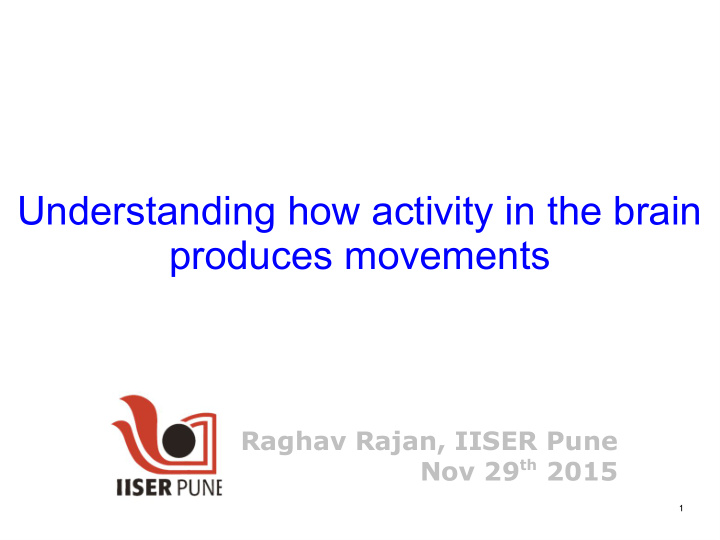



Understanding how activity in the brain produces movements Raghav Rajan, IISER Pune Nov 29 th 2015 1
We all make many different movements every day ● How do we make these movements? 2
Skeletal muscles in our body help us move our body parts ● We have ~640 skeletal muscles in our body ● Are required for different movements ● Muscles contract/relax to cause the movement ● How do these muscles work? 3 http://cdn.runningmagazine.ca/wp-content/uploads/2015/02/Muscles.jpg
Skeletal muscles work in pairs to “flex” or “extend” 4 https://www.youtube.com/watch?v=C6u0u_59UDc
Skeletal muscles work in pairs to “flex” or “extend” 5 https://www.youtube.com/watch?v=C6u0u_59UDc
Flexor-Extensor muscle pairs help to move different parts of the body ● What causes them to contract or relax? 6 http://www.benjaminreece.com/source_images/ill31_lg.html
Nerves provide the signals to make muscles contract or relax https://www.youtube.com/watch?v=C6u0u_59UDc 7
What is a neuron? ● Neurons are the basic units of the nervous system ● The brain has about 1 billion (1, 000, 000, 000) neurons ● Neurons transmit electrical signals 8 http://nbmpub.com/blog/wp-content/uploads/2013/08/17neuron-axon.gif
LIGHTS, CAMERA, ACTION POTENTIAL!! https://www.youtube.com/watch?v=XdCrZm_JAp0 9
Neurons connect with each other and pass messages to each other 10 https://www.youtube.com/watch?v=XdCrZm_JAp0
Neurons connect with each other and pass messages to each other ● Electrical signals from one neuron are passed on to other neurons ● 1,000,000,000 neurons ● 100,000,000,000,000 connections between neurons 11 http://rise.duke.edu/seek/pages/0105.html
So now, how are movements produced? ● What are the different types of movements? – Reflex actions – very basic movements – Voluntary actions – Movement sequences 12
Reflex actions are controlled from the spinal cord – No thinking involved! 13
How long does it take to remove your hand? ● Has to travel from from finger tip to spinal cord and back 14 http://georgi-georgiev.com/demo/websites/nervous-system/img/Reflex.gif
Electrical signals travel very fast ● Action potential lasts ~ 1ms (1/1000 th of a second) ● Speed at which one electrical signal travels – 0.5 – 100m/s – Or 1.8 km/hr – 360 km/hr ● As fast as a car on the road!! 15
So, this reflex action must take about 0.5s or sometimes as little as 0.05s!! ● Has to travel from from finger tip to spinal cord and back ● 0.5 second – Time for one eye-blink! 16 http://georgi-georgiev.com/demo/websites/nervous-system/img/Reflex.gif
Very specific response since Sensing Neuron is directly connected to Motor Neuron ● Other reflexes are also produced by direct activation of specific motor neurons http://georgi-georgiev.com/demo/websites/nervous-system/img/Reflex.gif http://e08595.medialib.glogster.com/rachelrainsforyou/media/2b/2b9f020 17 b0e019620e3cb693f24336793e136b995/reflex-arc.jpg
In a giraffe or a whale, how long would it take?! 30 m 5 m http://guardianlv.com/2014/06/endangered-species-blue- whales-are-the-largest-mammals-that-ever-lived/ 18 http://www.livescience.com/27336-giraffes.html
And what about dinosaurs? https://svpow.files.wordpress.com/2013/01/being-eaten-600.jpg 19
So now, how are movements produced? ● What are the different types of movements? – Reflex actions – very basic movements – Voluntary actions – Movement sequences 20
How fast are our voluntary movements? ● Reaction time – http://www.humanbenchmark.com/tests/reactiontime 21
What happens during voluntary movements? 22
What happens during voluntary movements? ● How do neurons in the motor area control different body parts? 23 http://my-ms.org/images/brain_functional_areas_600px.jpg
Neurons in different parts of the motor area of the brain control movement of different body parts 24 http://www.utdallas.edu/~tres/integ/mot2/2_08.jpg
Current view – neurons in different parts of motor cortex control different behaviorally relevant movements ● So then to produce a movement or movement sequence, CORRECT set of neurons need to be activated 25 https://www.princeton.edu/~graziano/neuron_07.pdf
Why so many other motor areas? ● Not fully understood ● Maybe for planning movements ● Or for executing movement sequences 26 http://my-ms.org/images/brain_functional_areas_600px.jpg
Men ought to know that from the brain, and from the brain only, arise our pleasures, joys, laughter and jests, as well as our sorrows, pains, griefs and tears. Through it, in particular, we think, see, hear, and distinguish the ugly from the beautiful, the bad from the good, the pleasant from the unpleasant Hippocrates 460-370 BC (2400 years ago!) 27
Music of the brain – Action Potentials 28
How I became a scientist Completed school with Maths, Physics, Chemistry, Biology – 1995 Did my Bachelors in Mechanical Engineering – finished in 1999 Did my PhD from National Centre for Biological Sciences, Bangalore (TIFR) – 1999-2006 Postdoctoral studies on songbirds at University of California at San Francisco (UCSF) – 2006 – 2012 Joined IISER Pune in 2013 29
My lab at IISER Pune 30
Our model system is the zebra finch, a songbird We are interested in understanding how movements are initiated in the brain? What happens in the bird-brain to make him sing? 31
Science/Research as a career – early stages ● IISERs – Integrated BS/MS immediately after school http://www.iiseradmission.in/ ● Fellowships available – KVPY, DST-INSPIRE http://kvpy.iisc.ernet.in/main/index.htm ● http://www.inspire-dst.gov.in/ 32
Science/Research as a career – later stages ● MSc by research – TIFR, Mumbai ● Integrated MSc/Ph.D program (after BSc) – NCBS, Bangalore – IISERs – IISc, Bangalore ● PhD program (after BTech/MTech/MSc) – All research institutes 33
“The most important thing is to not stop questioning. Curiosity has its own reason for existence. One cannot help but be in awe when he contemplates the mysteries of eternity, of life, of the marvelous structure of reality. It is enough if one tries merely to comprehend a little of this mystery each day. - Albert Einstein 34
Recommend
More recommend